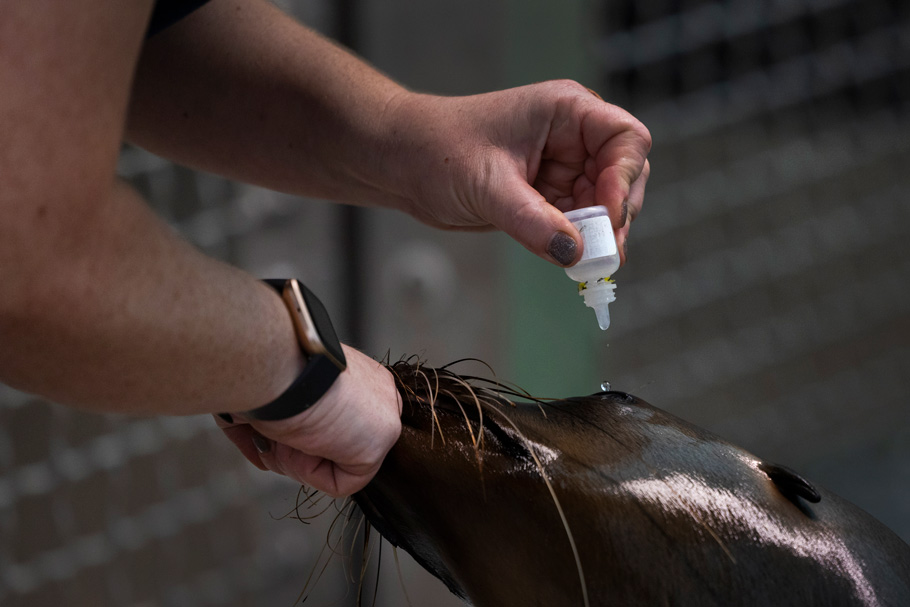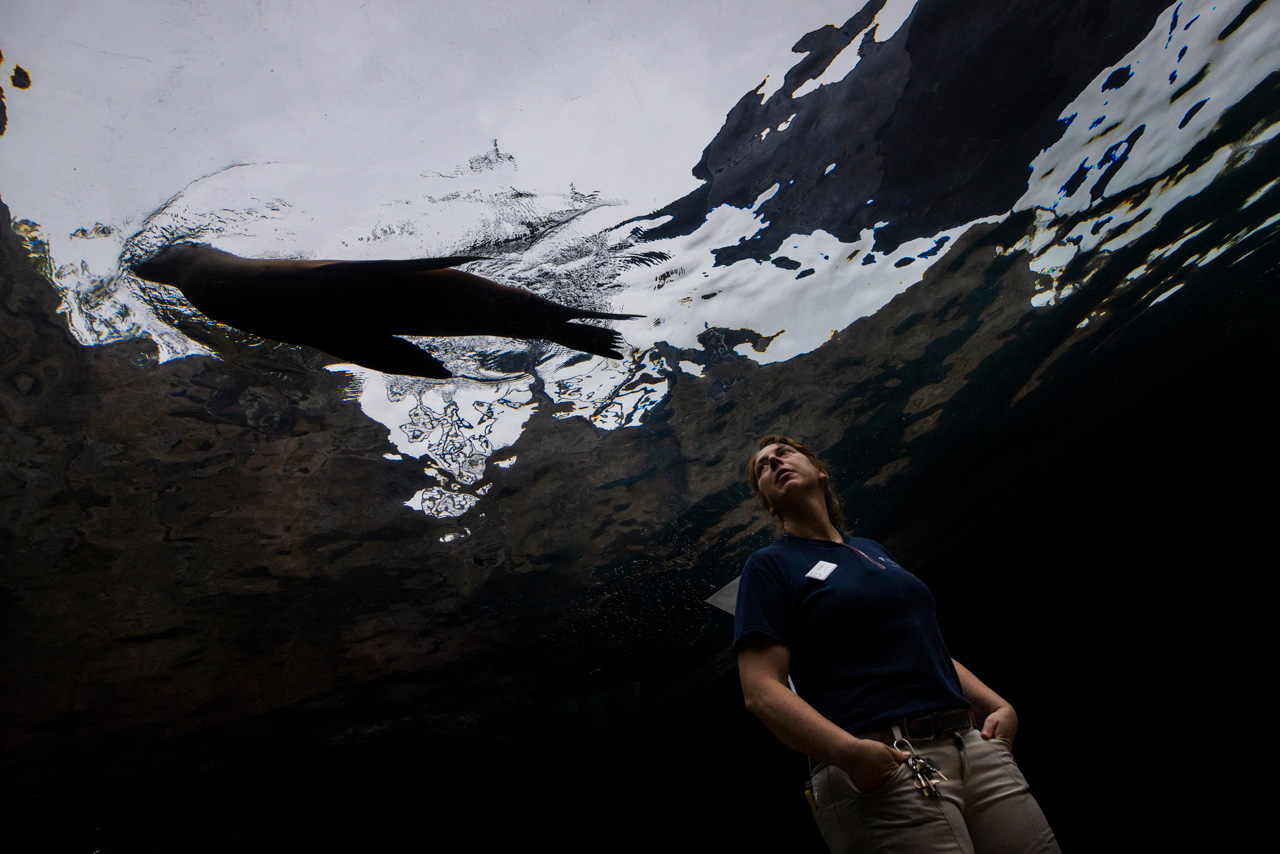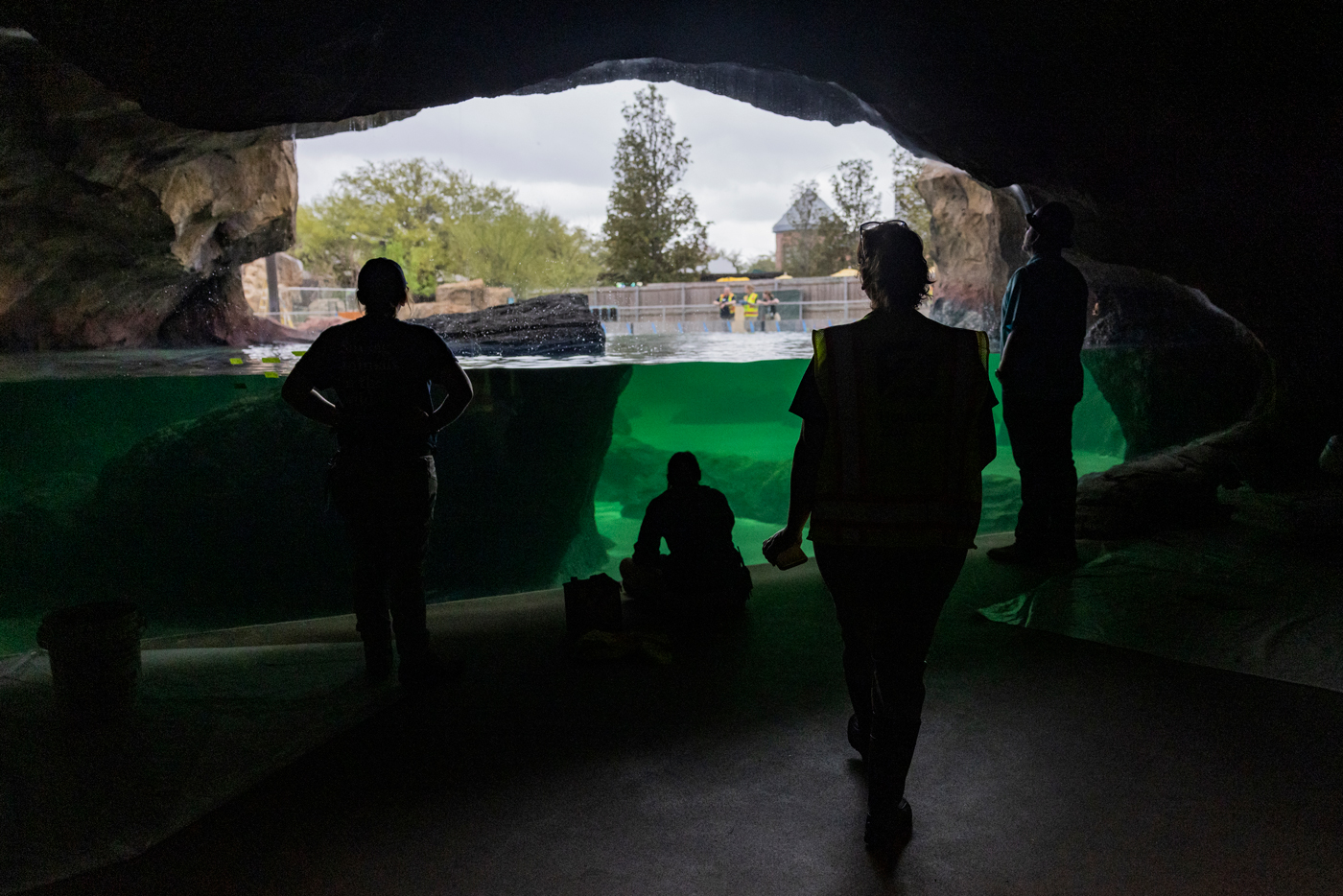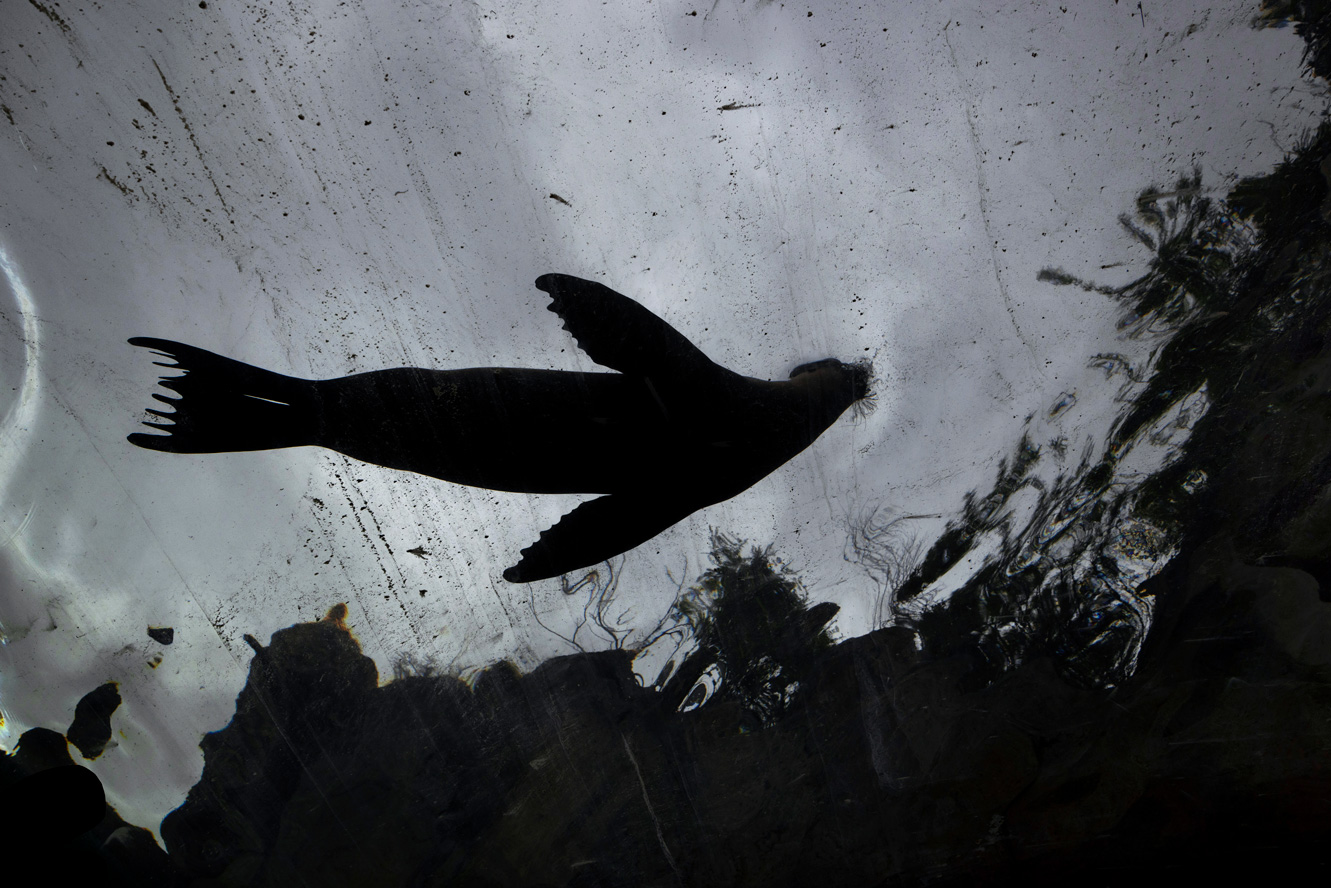Headlights cut into the darkness, two bright, bulbous eyes illuminating Krista Webber’s silhouette as she crouches and coos, tossing herring into a wooden crate.
It’s the first morning of spring break, and in a few hours, this place will quite literally be a zoo. But at this chilly, predawn moment, all eyes – including the forklift headlights – are on the sea lion inside the crate and her keeper, Webber, as they begin a high-stakes operation months in the making.
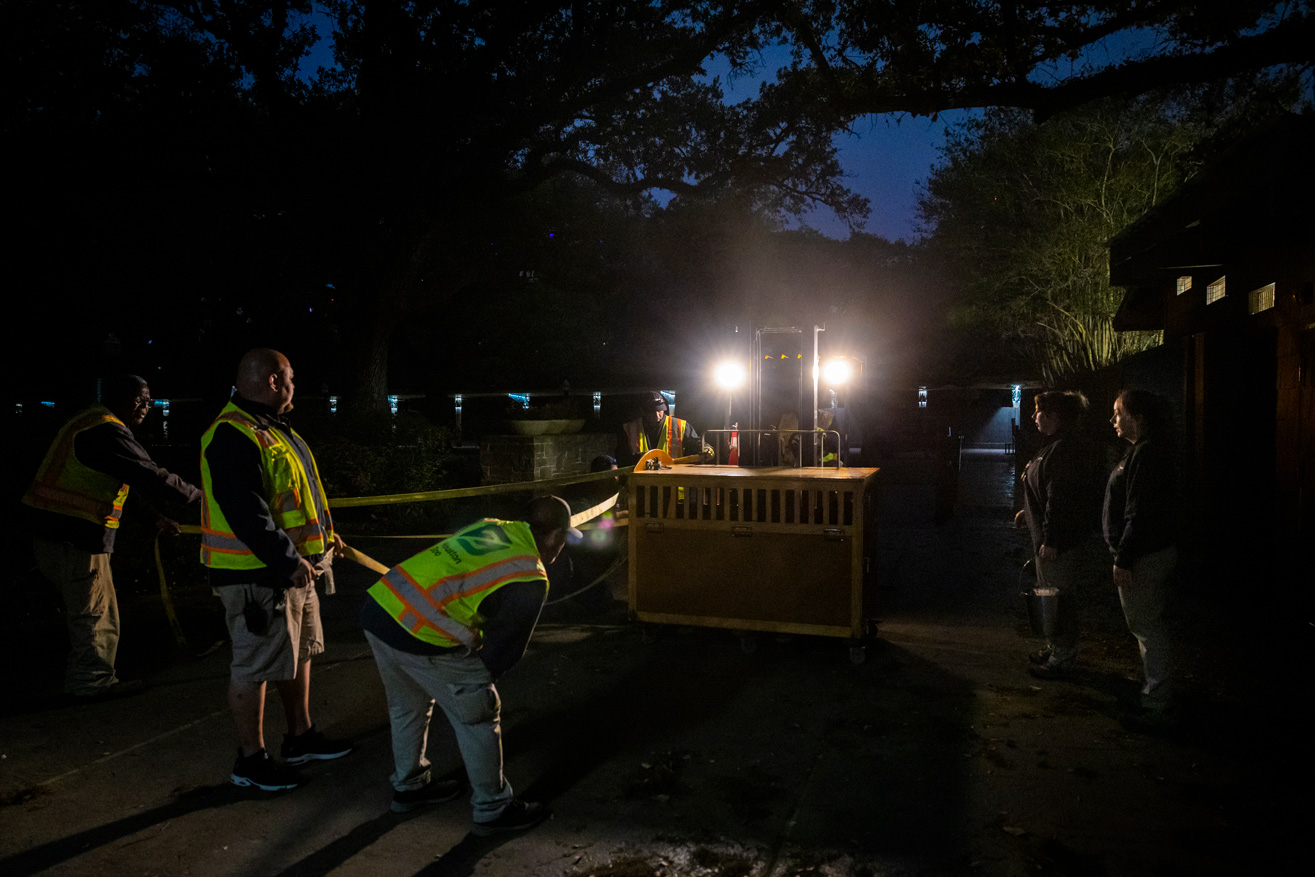
“Good girl, baby. Good girl,” Webber says, piercing the silence as she leans closer to Kamia, the 18-year-old sea lion she’s worked with for 16 years.
Today, zookeepers are moving Kamia from her current facility to a newer, shinier habitat a couple of hundred yards away, in preparation for the opening of the Houston Zoo’s most ambitious exhibit ever.
The sea lion team has repeatedly practiced loading Kamia and her family members into their wooden travel crates, to ease the animals' stress during this exact moment. But what happens next is new.
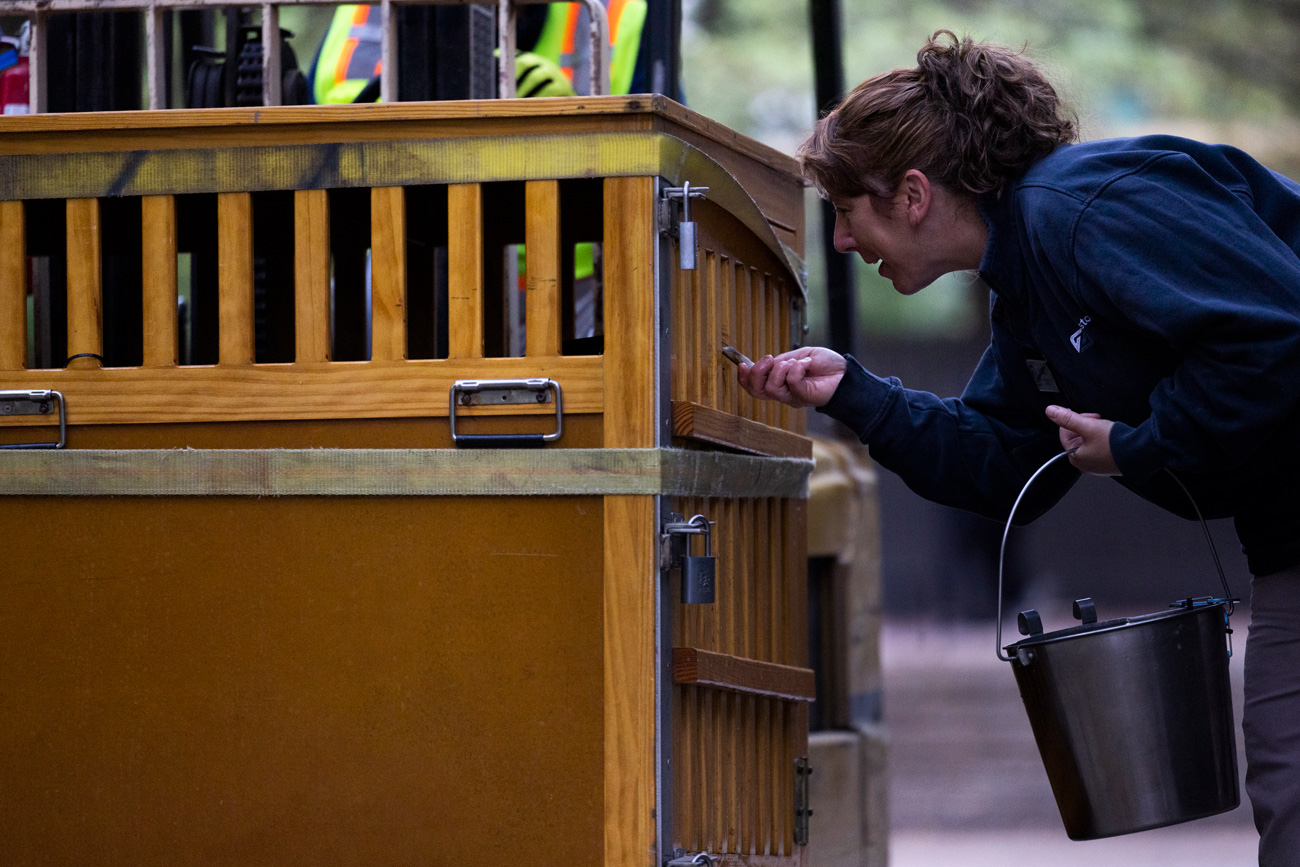
Webber’s coos – “Good. Goooooooood. You’re all right.” – are joined by a loud ratcheting sound, as belts crank tight around the crate and the forklift’s prongs slip beneath it.
“You’re all right,” Webber repeats. She hands Kamia another fish. “Oh, I love you so much, Good Girl.”
The forklift groans, and the crate eases off the ground.
It’s time to go.

A battle plan
This early morning move is both a monumental and incremental moment in the massive preparation process for the $72 million Galápagos Islands habitat opening Friday.
It’s the world’s first zoo exhibit dedicated to promoting conservation on the isolated Pacific islands, which are protected as a national park and UNESCO World Heritage Site. Most Galápagos animals are endemic, meaning you can’t find them anywhere else in the world. Not even in zoos.
In the early hours of March 13, Kamia and three other sea lions – her daughter TJ, her sister Cali and Cali’s son Max – are moving from the pool and surrounding facilities that have served as Houston’s sea lion headquarters since the 1950s to the new exhibit more than thrice its size.

Webber, the zoo’s supervisor of the sea lions and penguins program, has plotted every detail of the multiphase process – from crating to determining which sea lions will meet snout-to-snout first. Every move is fastidiously choreographed, down to the forklift operators, who underwent a dress rehearsal a few days earlier. It’s important to Webber to minimize stress on the animals. Initiate too much change at once, and a sea lion might stop eating.
Once settled in their new home, they’ll meet four sea lions joining their colony from a rescue facility in California: Calypso, Freya, Gaia and Ariel. Another stressor: Begin introductions before the sea lions are ready, and things could get physical.
These eight sea lions – along with the zoo’s alpha male, Jonah, who will join at a later date – are all California sea lions, a close cousin to those found on Galápagos. Yes, one toenail on a hind flipper looks a little different, but who will notice?
“Nobody will tell the difference,” says Kevin Hodge, vice president of animal programs at the Houston Zoo. “But we’re also not trying to hide that these are California sea lions standing in for the Galápagos sea lions, because Galápagos sea lions are protected.”
And the Houston Zoo’s greatest mission – as evidenced by the meticulous process Webber and her team have devised to combine colonies – is to ensure the safety and wellbeing of animals within its 55-acre campus and across the world. In recent years, zoo leaders have ramped up efforts to help visitors connect their in-zoo encounters with the need to help animals in the wild.
Sea lions – frisky, Frisbee-catching, fish-chomping, flipper-waving critters – easily win the hearts of visitors. Now, they will serve as stars of the Galápagos exhibit, Houston’s chief ambassadors to the zoo’s longstanding conservation efforts on the remote islands.
But not until Webber’s convinced they’re ready.

Changing philosophies
“Have you ever read ‘Curious George’?” I asked Webber a month earlier.
I knew it sounded like a digression from our discussion about sea lions. But to me, “Curious George” and these sea lions run together like a melody and harmony.
I’d just read it for the first (and second, and third…) time in decades, after pulling it from my daughter’s bookshelf a few months earlier. George, I reminded Webber, was minding his own monkey business in Africa when a British man in a yellow hat spotted him. “What a nice little monkey,” the man thought, placing his hat on the ground. “I would like to take him home with me.”
The man scooped up George and placed him in a bag. I gasped upon reading the next three words: George was caught.
His captor planned to bring George to England and place him in a zoo. That’s some pretty problematic imperialism, if you ask me. But in the 1940s, when Margret and H.A. Rey first wrote their books, people viewed “exotic” animals like George as commodities, ripe for relocation to faraway places for the benefit of onlookers.
The questions asked when planning exhibits centered on zoo-goers’ happiness, rather than that of the sea lions or monkeys.
Webber’s work is evidence of how far we’ve come as a society. Sure, the zoo wants the sea lions to dazzle little kids with their noses smudged against the exhibit’s acrylic divider. But at the end of the day, the sea lions’ wellbeing takes priority.
Social structures
It’s been three weeks since Kamia and company slow-rolled through the zoo on the forklifts, arriving at their new facility near the zoo’s entrance. From their separate “bedrooms,” they’ve been able to see, smell and hear the California girls.
Then, last week, the keepers opened the sea lions’ bedroom doors, allowing the four mature females – Kamia, Cali, Ariel and Calypso – to meet.
The foursome swims together for the first time in the 372,000-gallon sea lion habitat. As Kamia dances in the water, flitting past the underwater tunnel where the sea lion staff is gathered to monitor the experiment, she keeps one eye on Webber.
“She’s checking in on things,” Webber narrates. “She’s asking, ‘I’m doing OK, right? This is all right?’ We’ve had each other’s backs for a long time, her and I.”

Zoo workers are careful not to anthropomorphize animals: Kamia is a 209-pound marine animal, not a dummy that Webber can manipulate, inserting words into her mouth. But after 16 years together, Webber knows the sea lion’s mind.
Over the course of the few weeks I spent with the sea lion team, I saw Webber predict Kamia’s actions a few times. She knew Kamia and Ariel would battle for alpha female long before their introduction, during which they spun around each other, mouths open, in what Webber termed “mock charging” as they assessed each other’s dominance.
Kamia has been in charge for most of her life. Ariel, the alpha in her pack, has lived with more dominant females before. Webber predicts Kamia will retain her crown atop of the colony’s social hierarchy. Ariel will land just below her. Calypso, Gaia, Freya, Max and TJ will shuffle around in the middle of the pack. And Cali – who is so conflict-averse that she has not a scratch on her, and often serves as the zoo’s “model” for high-profile photo shoots – will gladly find her place at the bottom.
Real, empathetic life
This might sound like high school minutiae, but it’s not. Webber and her team must allow the sea lions to sort out their social structure before they introduce Jonah – an “intact,” or ready-to-breed male – who will increase stress throughout the pool.
It could take weeks until all nine sea lions can swim at once. And that’s OK, Webber says. Sure, it would be great if everyone is ready for Friday’s opening. But if it’s best for Kamia and company to frolic in their new habitat in groups of two or four, then that’s what visitors will see.
This isn’t a 20th-century children’s book about a monkey. This is real life, in a more empathetic time.
I still read “Curious George” to my daughter. You don’t have to agree with a book to learn from it. But the next time I slap its yellow cover closed and remind my daughter to treat animals with respect, I’ll think of one of the last scenes I observed in the tunnel:
A tear drops loose from Webber’s eye as she spots Kamia swimming past Ariel. It’s been a few moments since their open-mouthed exchange, and both sea lions are loose and nimble in their movement, signaling comfort and trust in a stressful situation. Kamia swishes by Webber, every part of her in motion, except for that one eye locked on her trusted keeper. “Good job,” Webber murmurs. “Good job.”
Share your Houston stories with me. We can start on Twitter, Facebook and Instagram. Or you can email me at [email protected].
Editor's note: Two captions in this article have been updated to correct the location of where the photo was taken.





